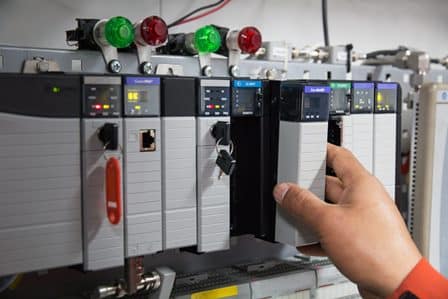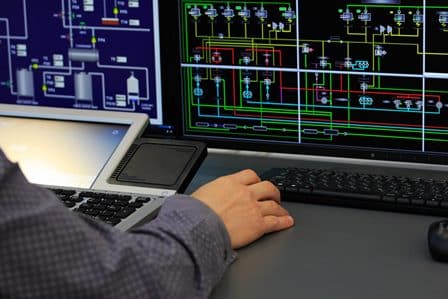52896WA Advanced Diploma of Civil and Structural Engineering (Materials Testing)
Investigation of the properties of construction materials, the principles which…Read moreGraduate Diploma of Engineering (Safety, Risk and Reliability)
The Graduate Diploma of Engineering (Civil: Structural) program covers 8…Read moreProfessional Certificate of Competency in Fundamentals of Electric Vehicles
Learn the fundamentals of building an electric vehicle, the components…Read moreProfessional Certificate of Competency in 5G Technology and Services
Learn 5G network applications and uses, network overview and new…Read moreProfessional Certificate of Competency in Clean Fuel Technology - Ultra Low Sulphur Fuels
Learn the fundamentals of Clean Fuel Technology - Ultra Low…Read moreProfessional Certificate of Competency in Battery Energy Storage and Applications
Through a scientific and practical approach, the Battery Energy Storage…Read more52910WA Graduate Certificate in Hydrogen Engineering and Management
Hydrogen has become a significant player in energy production and…Read moreProfessional Certificate of Competency in Hydrogen Powered Vehicles
This course is designed for engineers and professionals who are…Read more
Introduction to Microcontroller:
A microcontroller (μC or uC) is a solitary chip microcomputer fabricated from VLSI fabrication. A micro controller is also known as embedded controller. Today various types of microcontrollers are available in market with different word lengths such as 4bit, 8bit, 64bit and 128bit microcontrollers. Microcontroller is a compressed micro computer manufactured to control the functions of embedded systems in office machines, robots, home appliances, motor vehicles, and a number of other gadgets. A microcontroller is comprises components like – memory, peripherals and most importantly a processor. Microcontrollers are basically employed in devices that need a degree of control to be ap plied by the user of the device.
Microcontroller Basics:
Any electric appliance that stores, measures, displays information or calculates comprise of a
microcontroller chip inside it. The basic structure of a microcontroller comprise of: –
1. CPU- Microcontrol lers brain is named as CPU. CPU is the device which is employed to fetch data, decode it and at the end complete the assigned task successfully. With the help of CPU all the components of microcontroller is connected into a single system. Instruction fetch
ed by the programmable memory is decoded by the CPU.
2. Memory– In a microcontroller memory chip works same as microprocessor. Memory chip stores all programs & data. Microcontrollers are built with certain amount of ROM or RAM (EPROM, EEPROM, etc) or flash memory for the storage of program source codes.
3. Input/output ports– I/O ports are basically employed to interface or drive different appliances such as – printers, LCD’s, LED’s, etc.
4.Serial Ports– These ports give serial interfaces amid microcontroller & various other peripherals such as parallel port.
5.Timers– A microcontroller may be in-built with one or more timer or counters. The timers & counters control all counting & timing operations within a microcontroller. Timers are employed to count external pulses. The main operations performed by timers’ are-pulse generations, clock functions, frequency measuring, modulations, making oscillations, etc.
6.ADC (Analog to digital converter)–ADC is employed to convert analog signals to digital ones. The input signals need to be analog for ADC. The digital signal production can be employed for different digital applications (such as measurement gadgets).
7.DAC (digital to analog converter)–this converter executes opposite functions that ADC perform. This device is generally employed to supervise analog appliances like-DC motors, etc.
8.Interpret Control- This controller is employed for giving delayed control for a working program. The interpret can be internal or external.
9. Special Functioning Block– Some special microcontrollers manufactured for special appliances like – space systems, robots, etc, comprise of this special function block. This special block has additional ports so as to carry out some special operations.
Types of Microcontroller:
Microcontrollers are divided into categories according to their memory, architecture, bits and
instruction sets. So let’s discuss types of microcontrollers:
Bits:
8 bits microcontroller executes logic & arithmetic operations. Examples of 8 bits micro controller is Intel 8031/8051.
16 bits microcontroller executes with greater accuracy and performance in contrast to 8-bit.
Example of 16 bit microcontroller is Intel 8096.
32 bits microcontroller is employed mainly in automatically controlled appliances such as office machines, implantable medical appliances, etc. It requires 32 – bit instructions to carry out any logical or arithmetic function.
Memory:
- External Memory Microcontroller–When an embedded structure is built with a microcontroller which does not comprise of all the functioning blocks existing on a chip it is named as external memory microcontroller. For illustration – 8031 microcontroller does not have program memory on the chip.
- Embedded Memory Microcontroller – When an embedded structure is built with a microcontroller which comprise of all the functioning blocks existing on a chip it is named as embedded memory microcontroller. For illustration – 8051 microcontroller has all program & data memory, counters & timers, interrupts, I/O ports and therefore its embedded memory microcontroller.
Instruction Set:
CISC- CISC means complex instruction set computer, it allows the user to apply 1 instruction as
an alternative to many simple instructions.
RISC- RISC means Reduced Instruction Set Computers. RISC reduces the operation time by
shortening the clock cycle per instruction.
Memory Architecture:
- Harvard Memory Architecture Microcontroller
- Princeton Memory Architecture Microcontroller
8051 microcontroller:
The most universally employed set of microcontrollers come from the 8051 family. 8051 Microcontrollers persist to be an ideal choice for a huge group of hobbyists and experts. In the course of 8051, the humankind became eyewitness to the most ground- breaking set of microcontrollers. The original 8051 microcontroller was initially invented by Intel. The two other members of this 8051 family are-
- 8052-This microcontroller has 3 timers & 256 bytes of RAM. Additionally it has all the features of the traditional 8051 microcontroller. 8051 microcontroller is a subset of 8052 microcontroller.
- 8031 – This microcontroller is ROM less, other than that it has all the features of a traditional 8051 microcontroller. For execution an external ROM of size 64K bytes can be added to its chip.
8051 microcontroller brings into play 2 different sorts of memory such as – NV- RAM, UV – EPROM and Flash.
8051 Microcontroller Architecture:
8051 microcontroller is an eight bit microcontroller launched in the year 1981 by Intel Corporation. It is available in 40 pin DIP (dual inline package). It has 4kb of ROM (on- chip programmable space) and 128 bytes of RAM space which is inbuilt, if desired 64KB of external memory can be interfaced with the microcontroller. There are four parallel 8 bits ports which are easily programmable as well as addressable. An on- chip crystal oscillator is integrated in the microcontroller which has crystal frequency of 12MHz. In the microcontroller there is a serial input/output port which has 2 pins. Two timers of 16 bits are also incorporated in it; these timers can be employed as timer for internal functioning as well as counter for external functioning. The microcontroller comprise of 5 interrupt sources namely- Serial Port
Interrupt, Timer Interrupt 1, External Interrupt 0, Timer Interrupt 0, External Interrupt 1. The programming mode of this micro-
controller includes GPRs (general purpose registers), SFRs (special function registers) and SPRs (special purpose registers).
PIC Microcontroller:
Peripheral Interface Controller (PIC) provided by Micro-chip Technology to categorize its solitary chip microcontrollers. These appliances have been extremely successful in 8 bit micro-controllers. The foremost cause behind it is that Micro-chip Technology has been constantly upgrading the appliance architecture and included much required peripherals to the micro-controller to go well with clientele necessities. PIC microcontrollers are very popular amid hobbyists and industrialists; this is only cause of wide availability, low cost, large user base & serial programming capability.
PIC Microcontroller Architecture:
The architecture of the 8 bit PIC microcontrollers can be categorized as below-
1.Base Line Architecture-In the base-linearchitecture PIC microcontrollers of PIC10F family is included, other than that a fraction of PIC12 & PIC16 families are also included. These gadgets make use of 12 bit program word architecture with six to twenty-eight pin package alternatives.
Briefly defined attribute set of baseline architecture allows the most lucrative product solutions. This architecture is perfect for battery enabled gadgets. The PIC10F200 series is another reasonably priced 8 bit flash micro-controller with a 6 pin package.
2.Mid Range Architecture – In this midline member of PIC12 & PIC16 families are added that attribute 14 bit program word architecture. The midrange PIC16 gadgets proffer a broad variety of package alternatives (from 8 to 64 package), with low to high levels of peripheral
incorporation. This PIC16 appliance attributes a variety of analog, digital & serial peripherals, like – SPI, USART, I2C, USB, LCD & A/D converters. The mid-range PIC16 micro-controllers have suspended controlling ability with an eight level hardware load.
3.High Performance Architecture- The high performance architecture included the PIC18 family of appliances. These micro- controllers make use of 16 bit program word architecture along with 18 to 100 pin package alternatives. The PIC18 appliances are high performance micro-controllers with incorporated Analog to Digital converters. All PIC18 micro-controllers integrate a highly developed RISC architecture that supports flash appliances. The PIC18 has improved foundation attributes, 32 level deep load and several inner and exterior interrupts.
AVR Microcontroller:
AVR also known as Advanced Virtual RISC, is a customized Harvard architecture 8 bit RISC solitary
chip micro-controller. It was invented in the year 1966 by Atmel. Harvard architecture signifies that program & data are amassed in different spaces and are used simultaneously. It was one of the foremost micro-controller families to employ on- chip flash memory basically for storing program, as contrasting to one time programmable EPROM, EEPROM or ROM, utilized by other micro-controllers at the same time. Flash memory is a non-volatile (constant on power down) programmable memory. AVR Microcontroller Architecture:
AVR microcontrollers’ architecture was developed by Alf-Egil Bogen and Vegard Wollan. The name AVR is derived from the names of the architecture developers of the microcontroller. The AT90S8515 was the foremost micro-controller which was AVR architecture based; on the other hand the foremost micro-controller to strike the commercial marketplace was AT90S1200 which was launched in the year 1997.
The SRAM, Flash and EEPROM all are incorporated on a single chip, thereby eliminating the requirement of any other external memory in maximum devices. Several appliances comprise of parallel external bus alternative, so as to add extra data memory gadgets. Approximately all appliances, except TinyAVR chips comprise serial interface, which is used to link large serial Flash & EEPROMs chips.
AMR Microcontroller:
AMR is the name of a company that designs micro-processors architecture. It is also engaged in licensing them to the producers who fabricate genuine chips. In actuality AMR is a 32 bit genuine RISC architecture. It was initially developed in the year 1980 by Acorn Computers Ltd. This AMR base microprocessor does not have on-board flash memory. ARM is particularly designed for micro-controller devices, it is simple to be trained and make use of, however powerful enough for the most challenging embedded devices.
AMR Microcontroller Architecture:
The AMR architecture is a 32 bit RISC processor developed by ARM Ltd. Owing to its power-saving attributes, ARM central processing units are prevailing in the mobile electronics marketplace, where less power expenditure is a vital design aim. ARM architecture comprise of the underneath RISC elements:-
- Maximum single cycle functioning
- Constant 16×32 bit register file.
- Load or store architecture.
- Preset instruction width of 32 bits so as to simplify pipelining and decoding, at minimized code density.
- For misaligned memory access there is no support
Microcontroller Applications:
Microcontrollers are intended for embedded devices, in comparison to the micro-processors which are used in PCs or other all-
purpose devices. Microcontrollers are employed in automatically managed inventions and appliances like- power tools, implantable medical devices, automobile engine control systems, , office machines, remote controls appliances, toys and many more
embedded systems. By dipping the size and expenditure in comparison to a design that make use of a different micro-processor, I/O devices and memory, micro-controllers formulate it inexpensive to digitally control more & more appliances and operations. Mixed signal micro-
controllers are general; putting together analog constituents required controlling non-digital electronic structures.
Application of Microcontroller in Day to Day Life Devices:
- Light sensing & controlling devices
- Temperature sensing and controlling devices
- Fire detection & safety devices
- Industrial instrumentation devices
- Process control devices
Application of microcontroller in Industrial Control Devices:
- Industrial instrumentation devices
- Process control devices
Application of microcontroller in Metering & Measurement Devices:
- Volt Meter
- Measuring revolving objects
- Current meter
- Hand-held metering systems
Source: www.electronicshub.org/microcontrollers/
Professional Certificate of Competency in Advanced TCP/IP-Based Industrial Networking
Designed for engineers and technicians who need practical knowledge in…Read moreProfessional Certificate of Competency in Allen Bradley Controllogix / Logix5000 PLC Platforms
Designed for engineers and technicians who need practical knowledge in…Read moreProfessional Certificate of Competency in Arc Flash Protection
Designed for engineers and technicians who work in the electrical…Read moreProfessional Certificate of Competency in Chemical Engineering and Plant Design
Designed for engineers and technicians who need practical knowledge in…Read moreProfessional Certificate of Competency in Circuit Breakers, Switchgear and Power Transformers
Designed for engineers and technicians who need practical knowledge regarding…Read moreProfessional Certificate of Competency in Control Valve Sizing, Selection and Maintenance
Designed for engineers and technicians who need a solid understanding…Read moreProfessional Certificate of Competency in Electrical Power System Fundamentals for Non-Electrical Engineers
Designed for engineers and technicians who need to understand the…Read moreProfessional Certificate of Competency in Electrical Power System Protection
Designed for engineers and technicians who need practical skills and…Read moreProfessional Certificate of Competency in Electrical Wiring Standards: AS/NZS 3000:2018 (Australia and New Zealand Only)
This professional development course is designed for engineers and technicians…Read moreProfessional Certificate of Competency in Fundamental E & I Engineering for Oil and Gas Facilities
Designed for engineers and technicians who need to update their…Read moreProfessional Certificate of Competency in Gas Turbine Engineering
Designed for engineers and technicians who need practical skills in…Read moreProfessional Certificate of Competency in Hazardous Areas and Intrinsic Safety For Engineers and Technicians
Designed for engineers and technicians who need to understand the…Read moreProfessional Certificate of Competency in Heating, Ventilation and Air Conditioning (HVAC)
Designed for engineers and technicians from a wide range of…Read moreProfessional Certificate of Competency in IEC 61850 Based Substation Automation
Designed for engineers and technicians who need to understand the…Read moreProfessional Certificate of Competency in Industrial Data Communications
Designed for engineers and technicians who need to understand how…Read moreProfessional Certificate of Competency in Instrumentation, Automation and Process Control
Designed for engineers and technicians who need to gain practical…Read moreProfessional Certificate of Competency in Machine Learning and Artificial Intelligence
This professional development course is designed for engineers and technicians…Read moreProfessional Certificate of Competency in Mechanical Engineering
This professional development course is designed for engineers and technicians…Read moreProfessional Certificate of Competency in Onshore and Offshore Pipeline Systems
Designed for engineers and technicians who need to gain an…Read moreProfessional Certificate of Competency in Power Distribution
designed for engineers and technicians who need to gain a…Read moreProfessional Certificate of Competency in Practical Machine Learning Using Python for Engineers and Technicians
Designed to use Python Programming to work with machine learning…Read moreProfessional Certificate of Competency in Practical Python for Engineers and Technicians
Designed for engineers and technicians who need to understand the…Read moreProfessional Certificate of Competency in Programmable Logic Controllers (PLCs) & SCADA Systems
Designed for engineers and technicians who need to get practical…Read moreProfessional Certificate of Competency in Project Management for Engineers & Technicians
This professional development course is designed for engineers and technicians…Read moreProfessional Certificate of Competency in Safety Instrumentation Systems for Process Industries
Professional development course designed for engineers and technicians who want…Read moreProfessional Certificate of Competency in Sewage and Effluent Treatment Technologies
Designed for engineers and technicians who need practical skills and…Read moreProfessional Certificate of Competency in Structural Design for Non-Structural Engineers
Professional development course designed for engineers and technicians who need…Read moreProfessional Certificate of Competency in Substation Design (Main Equipment)
Professional development course is designed for engineers and technicians who…Read moreProfessional Certificate of Competency in Substation Design (Control, Protection and Facility Planning)
Designed for engineers and technicians who need to gain practical…Read moreProfessional Certificate of Competency in the Fundamentals of Process Plant Layout & Piping Design
Professional development course is designed for engineers and technicians who…Read moreProfessional Certificate of Competency in Practical Mechanical Sealing
This professional development course is designed for engineers and technicians…Read moreProfessional Certificate of Competency in Fundamentals of Road Construction
This professional development course is designed for engineers and technicians…Read moreProfessional Certificate of Competency in Specification and Technical Writing
Designed for engineers and technicians who need to understand how…Read moreProfessional Certificate of Competency in Hydraulics and Pneumatics
Overview of all aspects related to the construction, design, operation,…Read moreProfessional Certificate of Competency in Big Data and Analytics in Electricity Grids
This course explores the use of big data & data…Read moreProfessional Certificate of Competency in Renewable Energy Systems
This course covers various renewable energy systems that are popular…Read moreProfessional Certificate of Competency in Smart Grids
A smart grid is an electricity network that uses digital…Read moreProfessional Certificate of Competency in Hydrogen Energy – Production, Delivery, Storage, and Use
Hydrogen energy short course designed for engineers and professionals interested…Read moreProfessional Certificate of Competency in Earthing and Lightning Protection
Designed for engineers and technicians who need to understand the…Read moreProfessional Certificate of Competency in Building Information Modelling (BIM)
This professional development course is covering practical aspects of using…Read more















































